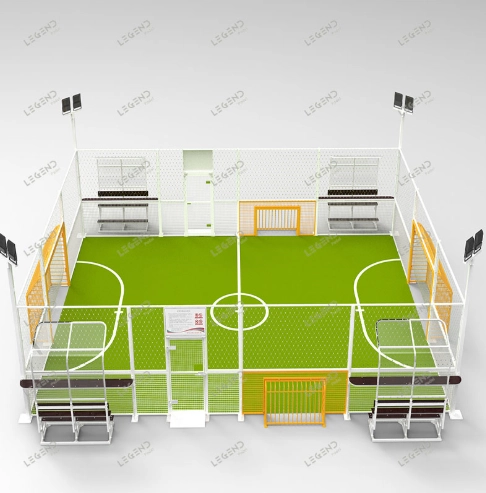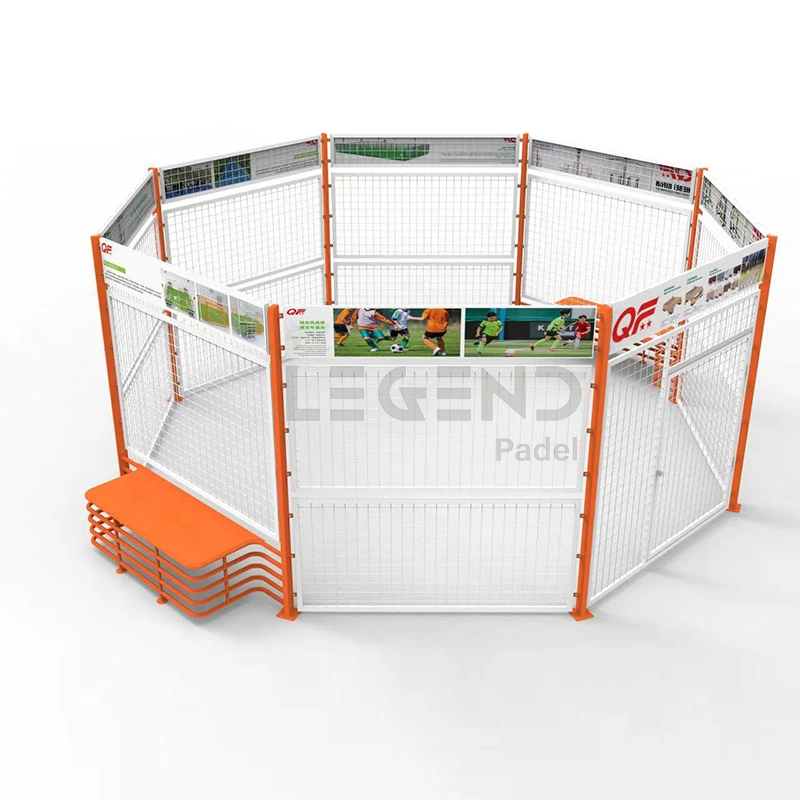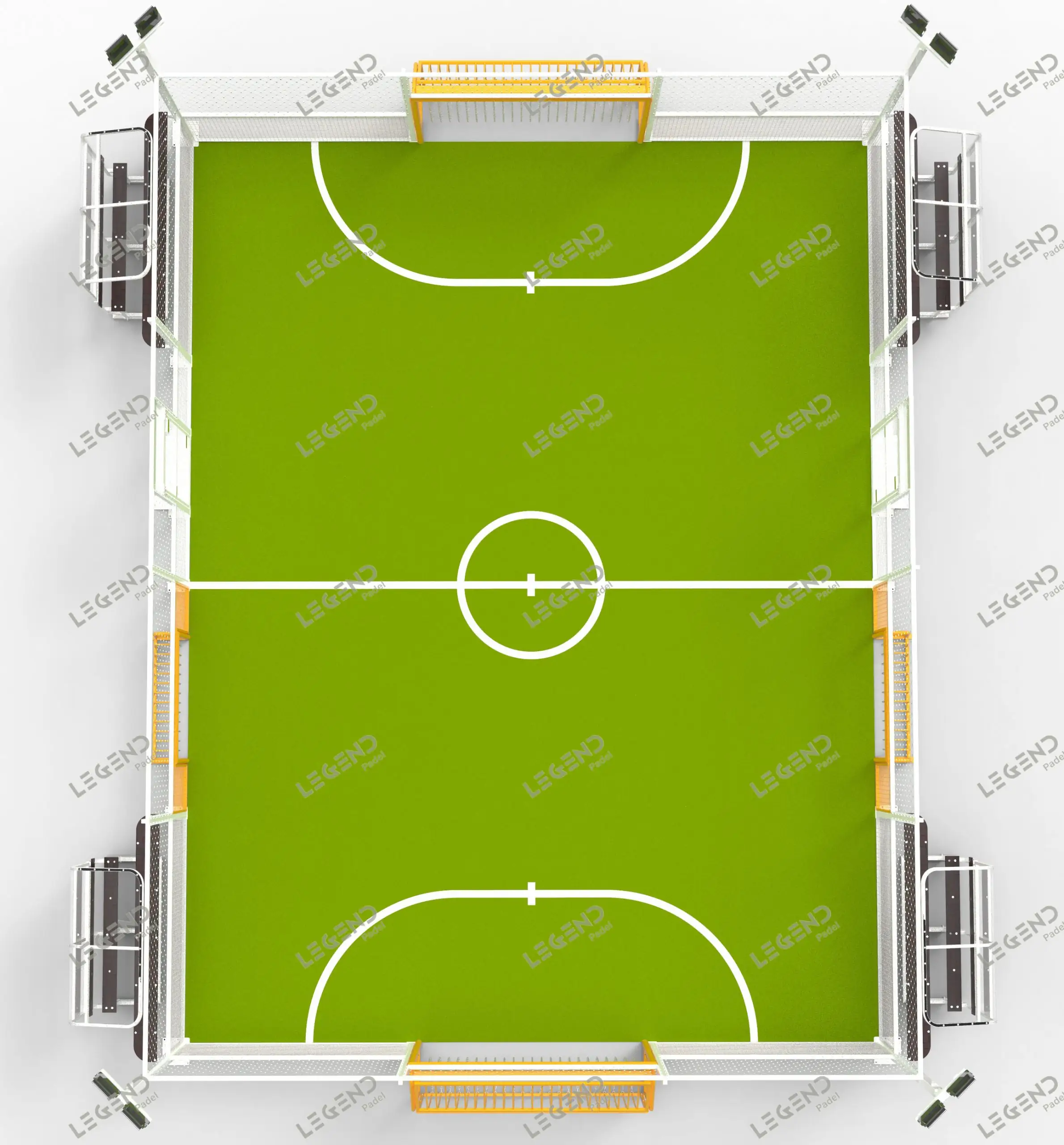Introduction au football en cage vs entraînement traditionnel
Définition du football en cage (Cageball)
Le football en cage, également appelé cageball, est un jeu animé de football. Il est joué dans une zone clôturée. Le terrain traditionnel de football en cage mesure 33 mètres de long et 22 mètres de large. Cette configuration encourage une interaction étroite avec les joueurs. Il améliore les compétences dans un espace compact. Notre QF-ZQ03 terrain de football modèle apporte des designs frais et des caractéristiques de sécurité fortes. Il convient aux joueurs de tous âges. L'espace étroit pousse les décisions rapides, le jeu rapproché et les compétences techniques aiguës.
Par exemple, le champ fermé maintient les jeux en flux. Il n'y a pas d'arrêt pour les balles hors limites. Cela renforce la concentration et l’endurance. Nos tribunaux utilisent des matériaux de qualité, assurant des matchs sûrs et amusants.
Pourquoi la comparaison des modes de formation est importante pour le développement des compétences
Il est essentiel de savoir comment le football en cage diffère de l'entraînement traditionnel. Chaque méthode forme les compétences de manière unique. Ils offrent différents avantages pour la croissance, de la capacité technique à l’intelligence du jeu. Les comparer aide les joueurs et les entraîneurs à choisir avec sagesse. Cela garantit que la formation correspond à leurs objectifs spécifiques.
Les deux approches ont des points forts. Le football en cage suscite une pensée rapide. Les exercices traditionnels font progresser régulièrement. Comprendre ces guides permet de mieux choisir la formation.
Différences fondamentales entre les méthodes de formation
Environnement et Dynamique du jeu dans Cage Football
Le football en cage se déroule dans un espace contrôlé et petit. Cela crée un gameplay rapide et intense. Le modèle QF-ZQ03 utilise du gazon artificiel en PE PP. Sa hauteur de l'herbe est de 25mm, assurant une résistance et une excellente performance. La configuration clôturée arrête les interruptions, comme les balles quittant le terrain. Cela maintient le jeu continu. Il améliore l'endurance et la concentration.
Les joueurs déplacent rapidement la balle dans des zones étroites. Ils interagissent étroitement, affinant leurs compétences. Nos cages de football sont construites pour cette action à haute énergie, en gardant les jeux en douceur et en sécurité.
Structure et La nature de l'entraînement traditionnel
La formation traditionnelle repose sur des exercices planifiés. Ces cibles ciblent des compétences spécifiques, comme passer ou défendre. Les sessions utilisent souvent des champs plus grands avec des tailles standard. Cela donne de la place à la planification stratégique. Les exercices se répètent pour construire la maîtrise au fil du temps. Ils créent une base solide pour les joueurs.
Par exemple, les joueurs pratiquent les longues passes ou le tir. La répétition améliore ces compétences. Contrairement au rythme rapide du football en cage, cette méthode est stable et structurée. Il construit des capacités de base pour les matchs.
Développement des compétences techniques
Contrôle de la balle, Passage rapide et Close-Quarters Play
Le football en cage exige des compétences techniques pointues. Le petit espace pousse les joueurs à bien contrôler la balle. Ils doivent passer rapidement et avec précision. Notre cages de footballcomme le QF-ZQ03, sont conçus pour cela. Ils obligent les joueurs à rester agiles et à s'adapter rapidement. Cela améliore leur capacité à gérer les points serrés.
Les joueurs apprennent à se déplacer avec précision. Les décisions rapides deviennent naturelles. La configuration de la cage donne à chaque moment une chance de grandir techniquement.
Ce qui favorise mieux la mémoire musculaire et la neuroplasticité
La mémoire musculaire se développe à travers des actions répétées. Les exercices traditionnels excellent ici. Ils verrouillaient des techniques, comme le passage, dans les habitudes des joueurs. Le football en cage améliore la flexibilité du cerveau. Ses scénarios en évolution rapide obligent à penser rapidement. Les joueurs s'adaptent à la volée, aiguisant leur esprit.
Les deux méthodes aident différemment. La formation traditionnelle renforce les compétences régulières. Le football en cage augmente l'agilité mentale. Ensemble, ils créent des joueurs polyvalents.
Tactique & Avantages de la prise de décision
Demandes cognitives en temps réel dans les matchs de cage
Football en cage défie l'esprit. Son rythme rapide laisse peu de temps à réfléchir. Les joueurs doivent décider immédiatement. Nos cages de football utilisent des matériaux forts, comme des tubes rectangulaires de 50x100x3mm. Ils assurent la durabilité tout en maintenant le jeu intense. Cette configuration pousse la croissance tactique.
Par exemple, un joueur doit choisir de passer ou de dribler rapidement. Il n’y a pas de place pour le retard. Cela aiguise la prise de décision sous pression, une compétence clé du jeu.
Transfert de compétences vers des scénarios de jeu à grande taille
Les deux méthodes aident dans les grands jeux mais de manière unique. Le football en cage améliore les compétences comme le dribble sous pression. Ceux-ci brillent dans les moments de match serré. Les passes rapides apprises dans la cage se transmettent dans des champs plus grands. La formation traditionnelle enseigne la coordination en équipe. Il aide les joueurs à comprendre le positionnement sur les grands terrains.
Par exemple, les compétences de cage aident dans un milieu de terrain bondé. Les exercices traditionnels aident dans les tactiques de jeu ouvert. Les deux préparent les joueurs pour les jeux du monde réel différemment.
Le football en cage est passionnant et crée une netteté technique. Sa configuration unique pousse l'adaptabilité. La formation traditionnelle se concentre sur une croissance constante. Il utilise des exercices planifiés pour la compétence et la stratégie. Le mélange des deux crée des joueurs prêts pour n'importe quel terrain.

Aspects physiques et conditionnants
Motifs d'intensité et de mouvement au format de cage à petits côtés
Le football en cage exige beaucoup d'énergie. Son petit terrain, de 33 mètres par 22 mètres, crée un jeu rapide. Les joueurs se déplacent constamment, sprintant et changeant de direction. La cage de football QF-ZQ03 utilise du gazon artificiel PE PP avec une hauteur d'herbe de 25mm. Cela assure une bonne adhérence et un mouvement régulier de la balle. L'espace étroit pousse l'agilité et l'endurance.
Les joueurs font des tours rapides et des courses courtes. Cela crée une puissance explosive. La conception de la cage maintient le jeu intense, aidant les joueurs à rester en forme et pointus.
Conditionnement physique et exercices d'agilité dans l'entraînement traditionnel
L'entraînement traditionnel vise la forme physique à travers des exercices planifiés. Celles-ci se produisent sur des champs de grande taille avec une gazonne standard, comme 10 500 aiguilles/m² de densité. Les entraîneurs créent des exercices pour la vitesse, la force ou l'endurance. Par exemple, les joueurs peuvent faire des sprints ou des side shuffles. Ces exercices se concentrent sur des objectifs de fitness spécifiques.
L'approche est moins animée que le football en cage. Cependant, il permet aux entraîneurs de personnaliser le conditionnement. Les joueurs développent des compétences athlétiques étape par étape, adaptées à leurs besoins.
Approches de formation intégrées
Mélanger des séances de cage avec des exercices traditionnels
Mélanger le football en cage avec des exercices traditionnels stimule la croissance. Les joueurs peuvent affiner leurs compétences techniques dans la cage de football QF-ZQ03. Ensuite, ils se déplacent sur des terrains ouverts pour des exercices de stratégie, comme de longues passes. La conception robuste de la cage, avec des tubes de 50x100x3mm, supporte les séances difficiles. Ce mélange crée une formation bien arrondie.
Par exemple, une session en cage améliore le dribble. Un exercice de terrain enseigne ensuite le positionnement. Ce mélange prépare les joueurs à tout scénario de jeu.
Créer des exercices similaires au jeu pour améliorer le transfert
Les exercices de jeu imitent de vrais matchs en pratique. Les entraîneurs peuvent organiser des matchs de petites équipes sur de grands terrains. Ceux-ci copient l’intensité du football en cage. Utiliser des objectifs en tuyaux en acier de 42 * 3mm ajoute du réalisme. Il maintient l'équipement dur et comme un jeu.
Ces exercices pont pratique et jeu. Les joueurs font face à la pression comme dans les cages mais sur des terrains plus grands. Cela aide à transférer les compétences aux vrais jeux.
Stratégies de périodisation et de coaching pour un développement optimal
La périodisation prévoit la formation en phases. Il équilibre le travail acharné et le repos. Les entraîneurs peuvent mélanger les séances de cage pour le travail de compétence avec des exercices de fitness. Cela évite le burnout. L’utilisation d’un éclairage intelligent dans les installations aide les séances du soir à rester concentrées.
Par exemple, une semaine de jeux en cage renforce la rapidité. Les exercices de la semaine prochaine renforcent l’endurance. Ce cycle permet aux joueurs de grandir sans effort.
Legend Sports: un pionnier dans la promotion du football en cage
Le rôle des sports légendaires dans la promotion du football en cage
Sports légendaires ont été à l'avant-garde de la promotion du football en cage grâce à des designs innovants comme le modèle QF-ZQ03. Avec plus de 20 ans d'expérience dans la construction de terrains de sport, nous nous spécialisons dans la personnalisation des domaines pour répondre à diverses exigences. Notre engagement envers la qualité assure que chaque cage de football que nous fabriquons respecte les normes internationales.
Équipements et programmes proposés par Legend Sports
Nos installations sont équipées de fonctionnalités de pointe telles que des systèmes d'éclairage intelligents qui ajustent la luminosité en fonction des besoins d'utilisation. Le gazon artificiel utilisé dans nos cages est fabriqué à partir de matériaux respectueux de l’environnement certifiés par la FIFA. Nous offrons également des services en guichet unique allant de la mesure du site à la construction, assurant une expérience sans faille pour nos clients.
Comment Legend Sports combine innovation et tradition
En alliant la technologie moderne à l’artisanat traditionnel, nous créons des produits qui répondent à la fois aux exigences contemporaines et aux valeurs intemporelles. Notre processus de production comprend des techniques de double pulvérisation pour une protection anti-rouille, assurant une durabilité même dans des conditions d'utilisation intenses. Cette approche nous permet de fournir des cages de football de haute qualité adaptées à diverses applications.

Conclusion et recommandations fondées sur des preuves
Quand utiliser le football en cage contre l'entraînement traditionnel
Le football en cage est idéal pour développer des compétences techniques telles que le contrôle étroit de la balle, le passage rapide et l'agilité sous pression. Il est particulièrement bénéfique pour les jeunes joueurs ou ceux qui cherchent à améliorer leurs temps de réaction dans des espaces restreints. L'entraînement traditionnel complète cela en mettant l'accent sur la compréhension tactique, la précision à long terme et le renforcement de l'endurance grâce à des exercices structurés sur des champs de grande taille.
Conseils pratiques pour les entraîneurs et les joueurs
- Combiner les méthodesAlterner entre les séances de football en cage comme celles menées sur la cage de football QF-ZQ03 et les exercices traditionnels sur le terrain pour atteindre un développement équilibré des compétences.
- Focus sur des objectifs spécifiquesUtilisez l'espace restreint d'une cage de football pour une précision technique tout en utilisant des champs plus grands pour des stratégies tactiques.
- Leverage Équipement de haute qualitéOptez pour des installations équipées de matériaux durables tels que la gazonne artificielle dotée de tissu textile PP à double couche pour assurer une performance constante.
- Incorporer la récupérationInclure des périodes de repos entre les séances de haute intensité pour prévenir la fatigue et promouvoir la croissance athlétique à long terme.
FAQ (questions fréquentes)
Question : Qu'est-ce qu'une cage de football ?
R: Une cage de football est une zone clôturée pour le football de petite taille. Le modèle QF-ZQ03 mesure 33m x 22m. Il favorise le jeu étroit et la sécurité avec des panneaux en maille soudé et des matériaux durables.
Question : Quelle méthode d’entraînement est bonne pour le football ?
R: Le football en cage et l'entraînement traditionnel aident tous les deux. Les cages améliorent l'agilité et les décisions rapides. Les exercices traditionnels renforcent la tactique, l'endurance et la précision. Les combiner fonctionne mieux.
Question : Quels sont les avantages d’une cage ?
R: Une cage de football offre des avantages clés:
- Jouer sans arrêt sans pauses hors limites en raison de sa conception clôturée.
- Sécurité à partir de matériaux forts, comme maille soudée 100x100mm.
- La petite taille stimule la pensée rapide et les compétences pour tous les âges.





